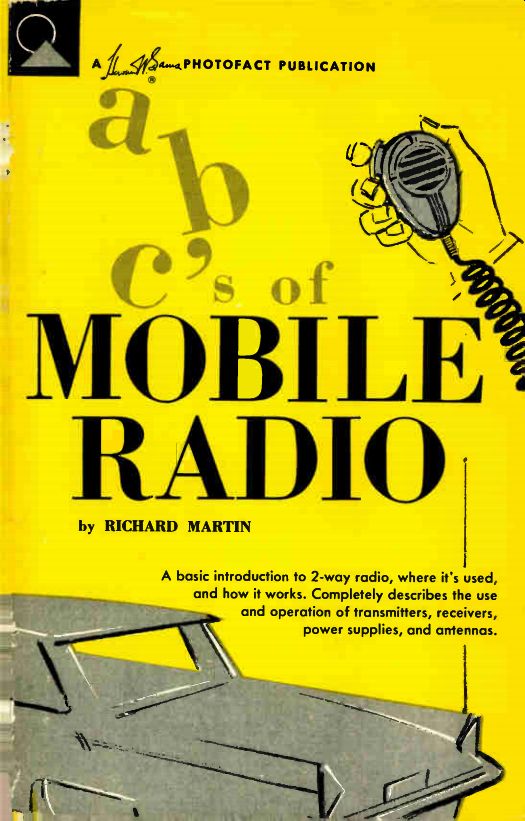A basic introduction to 2-way radio, where it's used, and how it works. Completely describes the use and operation of transmitters, receivers, power supplies, and antennas.
CONTENTS:
SECTION 1 Two-Way Radio Communications
SECTION 2 The Transmitter
SECTION 3 The FM Communications Receiver
SECTION 4 Power Supplies and Intercabling
SECTION 5 Antennas

Preface
While the telephone provides quick, convenient communications between two stationary points, it is still stationary. You cannot pick it up and take it with you.
Progress has thus created a strong demand for a more versa tile means of communications. People in service businesses, government activities, professional work, and many other fields need some means of keeping in touch with their offices and with each other. This need has been met by the use of radio.
Radio waves need no wires to travel through; therefore, any where a radio wave can go, communications can be maintained.
With the use of radio, police cars cruising streets, roads, and highways can be alerted at a moment's notice; a taxicab can be dispatched to a location within seconds; and a businessman need never lose contact with his office, not even while in his car.
ABC's of Mobile Radio was written for the benefit of users or potential users of two-way radio equipment, and technicians and students who need an introductory text on the subject. In addition to a complete explanation of mobile-radio communications systems and their applications, the content includes basic but comprehensive discussions of transmitter and receiver operation. Power supplies and antennas are also discussed.
My special thanks to the manufacturers who so willingly submitted some of the photographs and diagrams included herein, thereby making it possible to prepare a modern, up-to-date publication.
This guide is based on "abc's of MOBILE RADIO" by Richard Martin.
Richard Martin attended Purdue University, where he studied advanced physics and electronics. Having successfully completed several courses in radio, television, and radio communications, he spent several years in the two-way radio maintenance industry gaining practical experience. He has written a number of magazine articles on two-way radio.
Two-way mobile radio is finding so many uses in our modern way of life that it has become almost as important as the telephone. In fact, at the end of 1961, the number of licensed mobile units in operation was fast approaching the three million mark. The reason for such rapid growth is- easy to understand when you realize that commercial enterprises such as taxicabs, construction firms, and many other service businesses arc using this means of communications to great advantage.
ABC's of Mobile Radio provides a complete introduction to the subject for owners and operators, as well as technicians who are now servicing, or plan to service, two-way radio equipment. Beginning with a basic explanation of two-way radio communications systems and their applications, and followed by easy-to-understand descriptions of transmitter and receiver operation, this book contains information of value to anyone desiring knowledge of two-way mobile-radio systems and equipment.
HOWARD W. SAMS & CO., INC. THE BOBBS-MERRILL COMPANY, INC. $1.95 AMR-1
Also see:
Radio Communications Receivers -- A guide to radio receiver design and technology